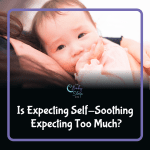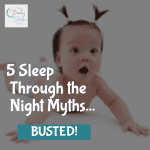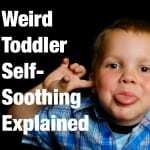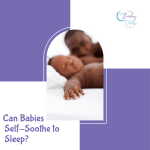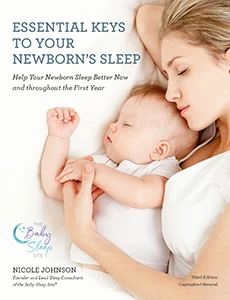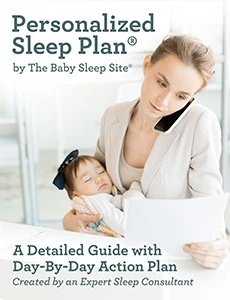
Google the phrase ‘self-soothing,’ and you know what you’ll find? You’ll find an assortment of the most contradictory articles you can imagine. You’ll find articles offering you tips on how to help your baby learn to self soothe, as well as articles telling you that self-soothing is impossible for babies, and that teaching a baby to self-soothe will lead to permanent emotional and psychological damage.
Gotta love the internet, right? 😉
But seriously, what’s a well-meaning parent to make of all this? As loving moms and dads, we want the best for our children. So what does that mean for self-soothing? Is self soothing a great thing to promote in your home (since a baby who can self-soothe is a baby who is on the road to sleeping through the night), or is self soothing dangerous, and something that “selfish” parents inflict upon their little ones?
 As usual, we’ve got answers! Miriam Chickering, registered nurse, lactation consultant, and experienced sleep consultant, is joining us today, sharing her wisdom, and helping us to debunk 2 of the most common (and most obnoxious!) self-soothing myths. Read on for information on why babies CAN, in fact, learn to self-soothe, and why helping a baby learn to self soothe isn’t the dangerous, cruel act some would have you believe it is.
As usual, we’ve got answers! Miriam Chickering, registered nurse, lactation consultant, and experienced sleep consultant, is joining us today, sharing her wisdom, and helping us to debunk 2 of the most common (and most obnoxious!) self-soothing myths. Read on for information on why babies CAN, in fact, learn to self-soothe, and why helping a baby learn to self soothe isn’t the dangerous, cruel act some would have you believe it is.
MYTH #1: Babies aren’t capable of self-soothing.
Not so – babies absolutely can learn gradually, over time, how to soothe themselves! Keep reading for Miriam’s explanation:
“Babies can absolutely self soothe – in fact, babies as young as a week old are capable of sucking on their fists when distressed or hungry. While this can be taken as a hunger cue, this is also the baby’s way of regulating and decreasing stress. It’s an instinctual behavior. But, pretty soon, the 3-4 month old baby will, in a very coordinated and deliberate way, suck his fingers to help himself get to sleep. So, on all counts, infants absolutely can decrease their stress without outside help.
So, the question becomes not, ‘Can my baby self soothe?’ but, ‘Does my baby need additional soothing beyond his existing self soothing abilities in order to sleep?’
Now, to answer this more accurate question, we need to first understand the complex factors that lead to good sleep regulation in infants. ‘Behavioral sleep intervention’, or sleep training, is generally not all that effective when used alone, especially in babies 6 months and under. Why? Because in many cases, with young infants, their sleep (or lack thereof) is driven by non-behavioral factors.
See, babies are able to fall asleep more easily if certain conditions are met. For example, your baby will fall asleep more easily if she has a full tummy, is warm (but not too warm), feels safe, and is beginning to feel tired (but not over-tired). None of these factors are part of conventional sleep training methodology (unless, that is, you’re working with The Baby Sleep Site® – we’re all about holistic sleep coaching!), but they’re all key components in helping your baby sleep well!
The truth is, your baby’s feeding and sleep schedule, any medical concerns, your bond with your baby, your child’s temperament, and your parenting philosophy ALL play a part in how your baby regulates sleep. Once the conditions are right, and ‘the stage has been set’ for sleep, then and only then, should parents address how baby is falling asleep.
What do I mean by how baby is falling asleep? Simply this – think about what your baby needs in order to fall asleep and then stay asleep (I don’t mean stay asleep for 12 hours, necessarily – just stay asleep for a 2 or 3-hour chunk). If your baby wakes often throughout the night, and has a hard time sleeping independently, even after you’ve addressed all the ‘setting the stage’ factors (like schedule, sleeping environment, etc.), then your baby almost certainly has what The Baby Sleep Site® calls a limiting sleep association. A limiting sleep association is any activity you do that helps your baby fall asleep (and stay asleep) that isn’t sustainable for the entire period of sleep. Think rocking/nursing/patting/holding in arms (after all, we parents aren’t machines who can do these activities indefinitely!). Note that these are different than healthy sleep associations (like having a darkened room, white noise, etc.) – good sleep associations are those things that your child associates with sleep, but that don’t require ongoing work from you throughout the night.
In cases where there is a limiting sleep association present, your job is to gradually wean your baby away from the limiting sleep association, and to help your baby learn to fall asleep independently. And how does a baby learn to do that? You guessed it…by self-soothing to sleep!
Now, I should point out that one does not expect an infant to self soothe the way an older child or adult would. If you consider the ways that you regulate your stress and emotions, it’s obvious that you wouldn’t expect your baby to do the same! And in this way, the ability to self soothe is something that grows and matures as your child grows and matures. However, when the surrounding conditions are favorable, a baby can learn the skill of going to sleep without a limiting sleep association – in other words, a baby can learn to self-soothe to sleep.
MYTH #2: Babies who “self-soothe” aren’t really self-soothing – they’re just giving up.
Oh, this one really gets our goat…fortunately, it’s not true! Read Miriam’s thoughts on this especially frustrating myth:
“When people say this, they usually mean that when a baby stops crying after sleep coaching, he hasn’t actually learned how to self soothe and fall asleep independently; rather, he has learned that no one comes when he cries, so he might as well give up and not cry at all. In other words, it is assumed that he has been exposed to a TOXIC amount of stress.
What’s toxic stress, exactly? Toxic stress results from frequent and prolonged abuse and/or neglect. According to Harvard University’s Center on the Developing Child, this kind of prolonged activation of the stress response systems can disrupt the development of brain architecture and other organ systems, and increase the risk for stress-related disease and cognitive impairment, well into the adult years.
Scary, right? This myth is especially cruel because it’s downright frightening. Fortunately, you can put your mind at ease, because in loving, healthy families, this simply will not happen.
Now, let me clarify – does toxic stress happen? Yes, when children are exposed to prolonged abuse, neglect, and adult violence. There have actually been a number of studies done over the years that support this concept:
- Biological Psychiatry Journal Abstract
- Child Development Abstract
- National Academy of Sciences Abstract
BUT – does toxic stress occur when thoughtful, loving parents adequately ‘set the stage’ for sleep and then take a holistic approach to sleep coaching, and to helping their babies learn to self soothe? According to Harvard and the American Academy of Pediatrics – no! Even if theat sleep coaching process involves some crying (for instance, if the parents use a check-and-console approach to helping their baby learn to self soothe and fall asleep independently) – in no way is that child’s controlled crying in a loving, nurturing, supportive environment even remotely similar to a neglected child crying in an abusive, violent environment. To call these two scenarios similar, and to allege that in both cases, the child is experiencing toxic stress, is ludicrous.
So here is the deep, deep flaw that busts this myth: anti-sleep coaching proponents take all of that toxic stress research, and use it to ‘prove’ that sleep coaching is cruel, and that babies don’t actually self soothe, but merely give up and continue to experience emotional and psychological distress. But this is simply not true; if you are teaching your baby to self-soothe and fall asleep independently in a loving and nurturing environment, then there is no way that your baby is going to experience toxic stress!
So what’s really happening when sleep coaching works, and a baby learns self-soothing? The baby has not been exposed to toxic stress, and has not learned to simply ‘give up’; rather, that child has learned the skill of going to sleep without relying on a limiting sleep association. You, the parents, are now able to sleep because you are not required to help your child fall back to sleep every time she wakes.
One last point – lots of the self-soothing myth perpetrators claim that even after babies learn to fall asleep independently without crying, they stay stressed. There was a 2012 study that seemed to indicate that babies who were left to cry during sleep training had elevated levels of cortisol – a stress hormone – in their brains. However, this is another myth we need to bust; that study was profoundly flawed. If you’re interested in learning more, this article offers a great analysis of the many flaws in that study.”
Parents, I hope that Miriam’s thoughtful responses to these 2 self-soothing myths have set your mind at ease and have given you confidence in your efforts to help your children sleep well.

